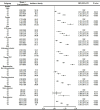Association between the triglyceride to high density lipoprotein cholesterol ratio and the incidence of metabolic dysfunction-associated fatty liver disease: a retrospective cohort study
- PMID: 39487389
- PMCID: PMC11528993
- DOI: 10.1186/s12876-024-03471-w
Association between the triglyceride to high density lipoprotein cholesterol ratio and the incidence of metabolic dysfunction-associated fatty liver disease: a retrospective cohort study
Abstract
Background: The triglyceride to high density lipoprotein cholesterol ratio (TG/HDL-C) is a confirmed predictive factor for insulin resistance and is suggested to be closely related to metabolic dysfunction-associated fatty liver disease (MAFLD), but previous research is inconclusive. The association between TG/HDL-C and MAFLD incidence was further explored in this large-sample, long-term retrospective cohort study.
Methods: Individuals who participated in the Kailuan Group health examination from July 2006 to December 2007 (n = 49,518) were included. Data from anthropometric and biochemical indices, epidemiological surveys, and liver ultrasound examinations were collected and analysed statistically, focusing on the association between TG/HDL-C and the incidence of MAFLD.
Results: During a mean follow-up period of 7.62 ± 3.99 years, 24,838 participants developed MAFLD. The cumulative MAFLD incidence rates associated with the first to fourth quartiles of TG/HDL-C were 59.16%, 65.04%, 71.27%, and 79.28%, respectively. The multivariate Cox proportional hazards regression model revealed that the hazard ratios (HRs) (95% CIs) for MAFLD in the second, third, and fourth quartiles were 1.20 (1.16-1.25), 1.50 (1.45-1.56), and 2.02 (1.95-2.10) (P for trend < 0.05), respectively, and the HR (95% CI) corresponding to an increase of one standard deviation in TG/HDL-C was 1.10 (1.09-1.11) (P < 0.05). Subsequent subgroup and sensitivity analyses yielded results similar to those of the main analyses.
Conclusions: TG/HDL-C is independently associated with MAFLD risk, with higher TG/HDL-C indicating greater MAFLD risk.
Keywords: Cohort study; Metabolic dysfunction-associated fatty liver disease; TG/HDL-C ratio.
© 2024. The Author(s).
Conflict of interest statement
The authors declare no competing interests.
Figures




References
-
- Powell EE, Wong VW, Rinella M. Non-alcoholic fatty liver disease [J]. Lancet. 2021;397(10290):2212–24. 10.1016/S0140-6736(20)32511-3. - PubMed
-
- Gasevic D, Frohlich J, Mancini GB, et al. The association between triglyceride to high-density-lipoprotein cholesterol ratio and insulin resistance in a multiethnic primary prevention cohort [J]. Metabolism. 2012;61(4):583–9. 10.1016/j.metabol.2011.09.009. - PubMed
-
- He S, Wang S, Chen X, et al. Higher ratio of triglyceride to high-density lipoprotein cholesterol may predispose to diabetes mellitus: 15-year prospective study in a general population [J]. Metabolism. 2012;61(1):30–6. 10.1016/j.metabol.2011.05.007. - PubMed
MeSH terms
Substances
LinkOut - more resources
Full Text Sources
Medical
Miscellaneous

